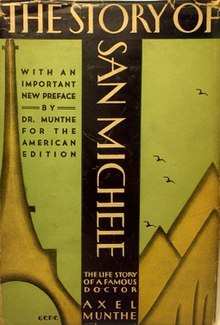The Story of San Michele
 |
|
| Author | Axel Munthe |
|---|---|
| Original title | The Story of San Michele |
| Country | England |
| Language | English |
| Genre | Memoirs, autobiography, novel |
| Publisher | John Murray |
|
Publication date
|
1929 |
The Story of San Michele is a book of memoirs by Swedish physician Axel Munthe (October 31, 1857 – February 11, 1949) first published in 1929 by British publisher John Murray. Written in English, it was a best-seller in numerous languages and has been republished constantly in the over seven decades since its original release.
Munthe grew up in Sweden. At the age of seventeen, he was on a sailing trip which included a brief visit to the Italian island of Capri. Hiking up the Phoenician steps to the village of Anacapri, Munthe came across a ruined chapel owned by a nearby resident, Maestro Vincenzo, and fantasized owning and restoring the property. The chapel, dedicated to San Michele, had been built on some of the ruins of Roman Emperor Tiberius' villa.
Munthe went to medical school in France and then opened a medical practice in Paris. He later assisted in the 1884 cholera epidemic in Naples. In 1887, he managed to buy the ruined chapel, and subsequently spent much of his life on Capri building the Villa San Michele. Munthe also had a medical practice in Rome in order to help pay for construction.
The Story of San Michele has 32 chapters, approximately 368 pages. It is a series of overlapping vignettes, roughly but not entirely in chronological order. It contains reminiscences of many periods of his life. He associated with a number of celebrities of his times, including Jean-Martin Charcot, Louis Pasteur, Henry James, and Guy de Maupassant, all of whom figure in the book. He also associated with the very poorest of people, including Italian immigrants in Paris and plague victims in Naples, as well as rural people such as the residents of Capri, and the Nordic Lapplanders. He was an unabashed animal lover, and animals figure prominently in several stories.
...
Wikipedia
